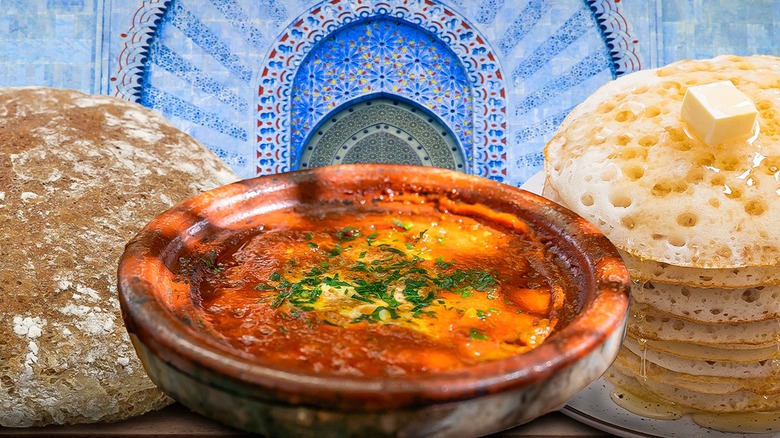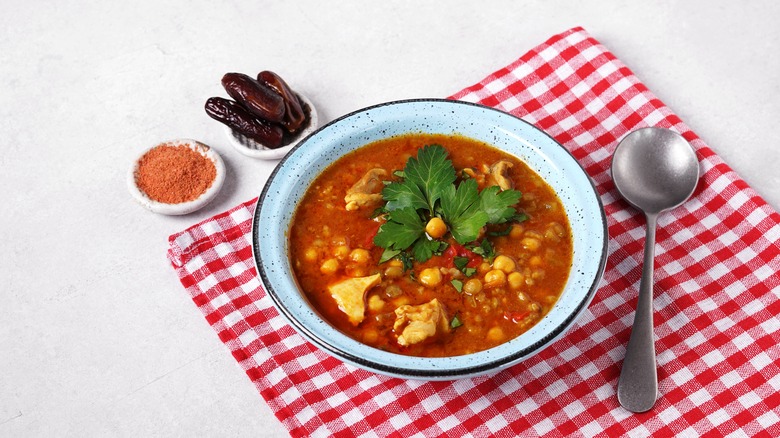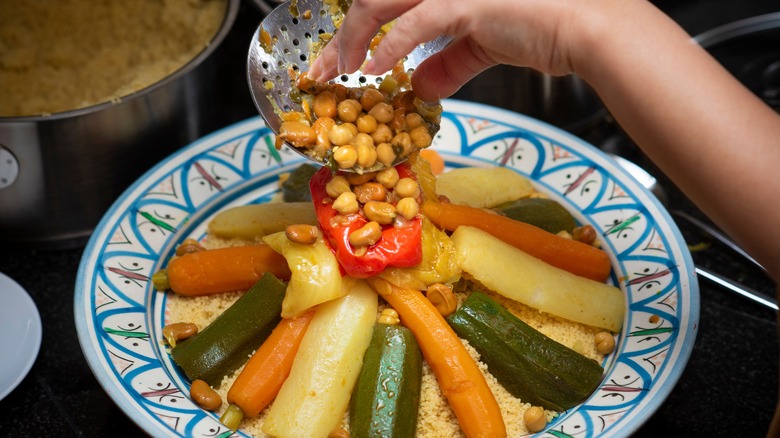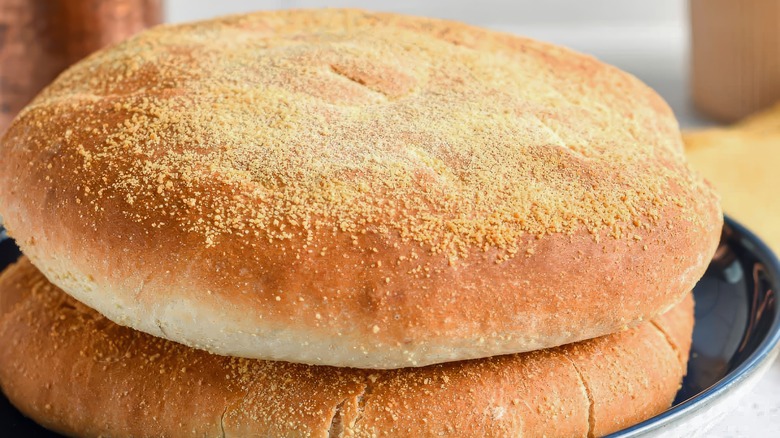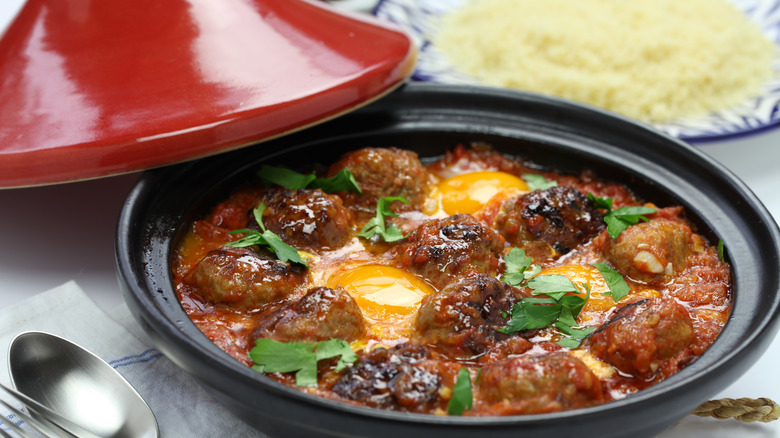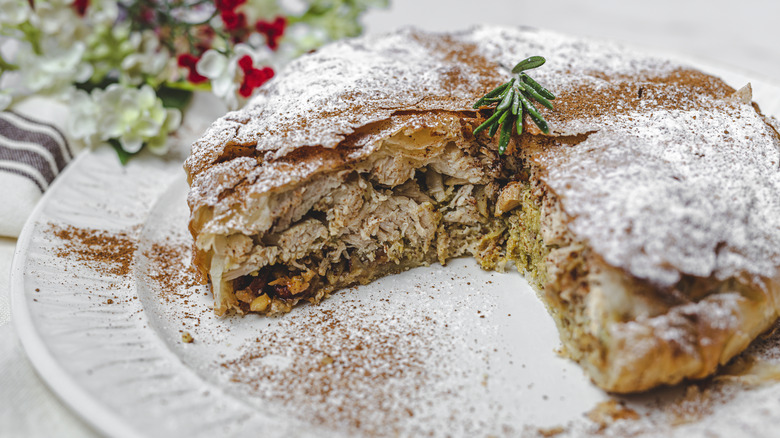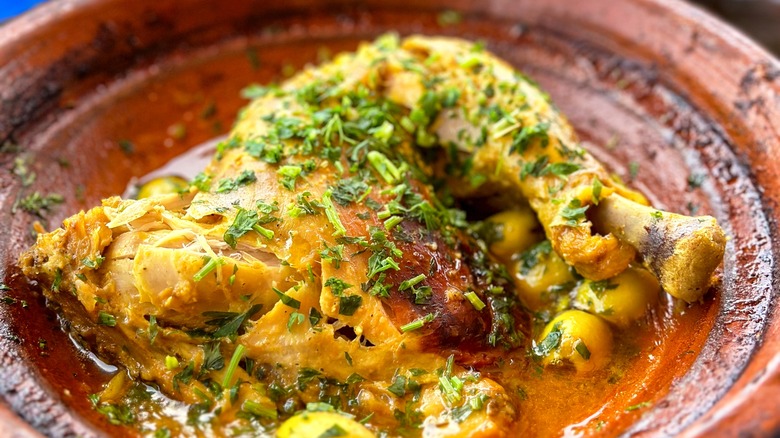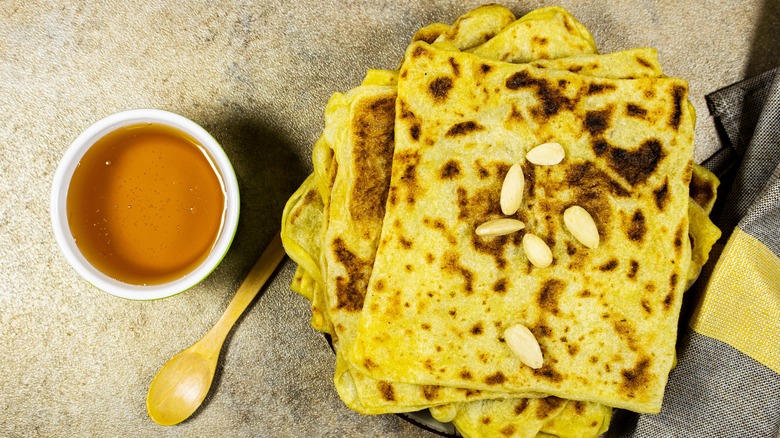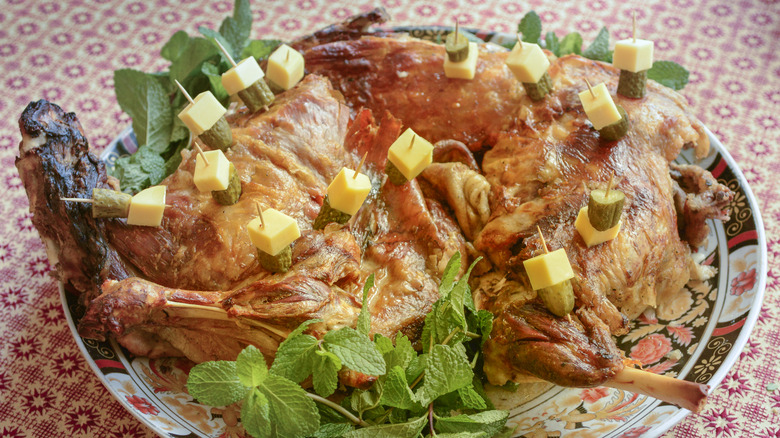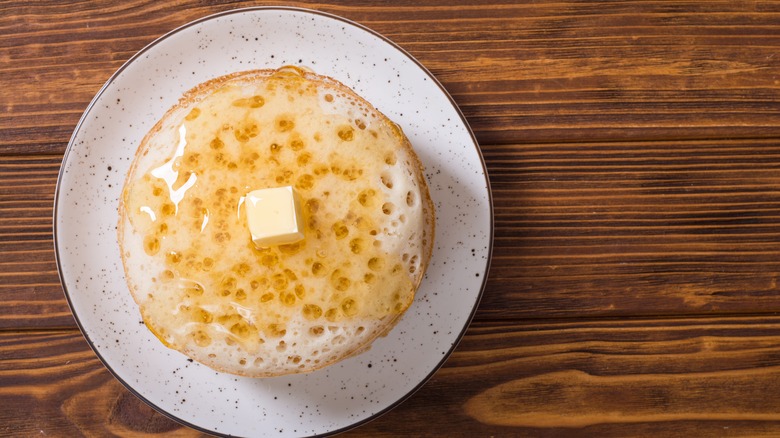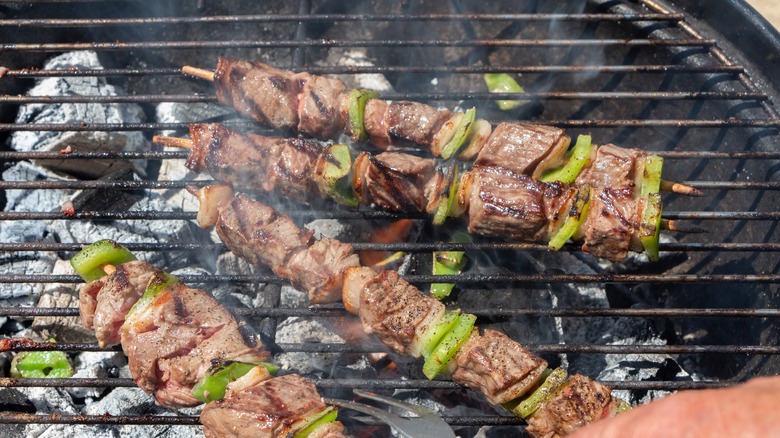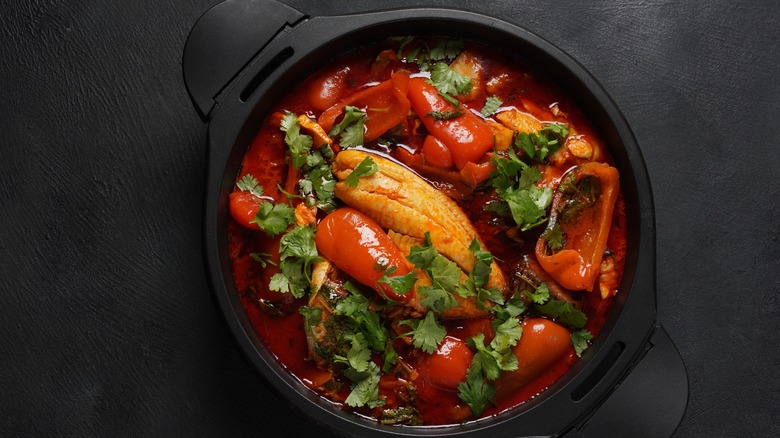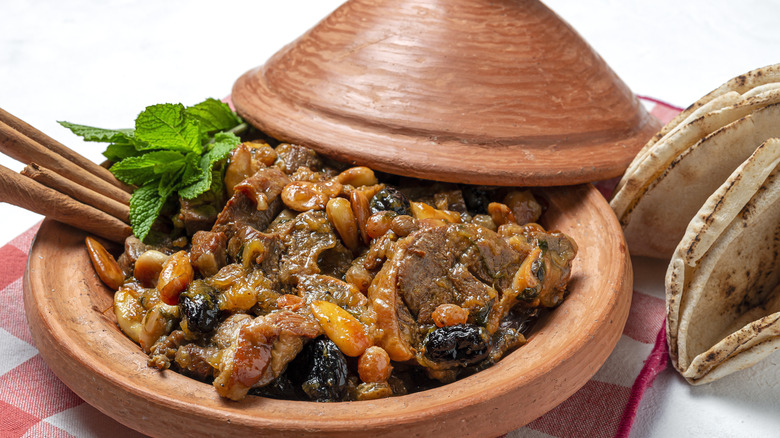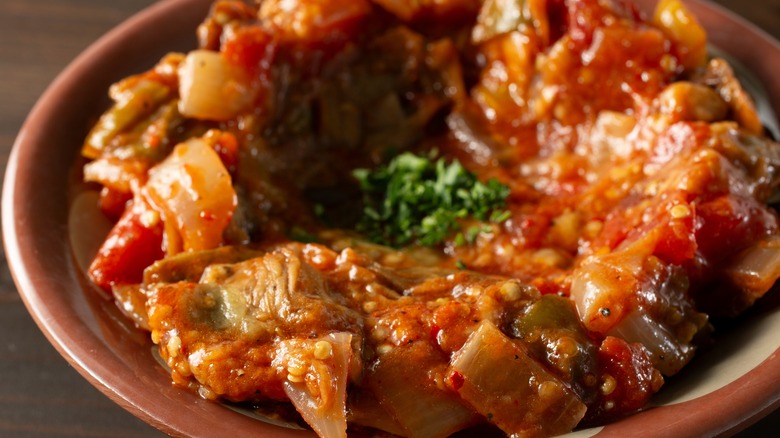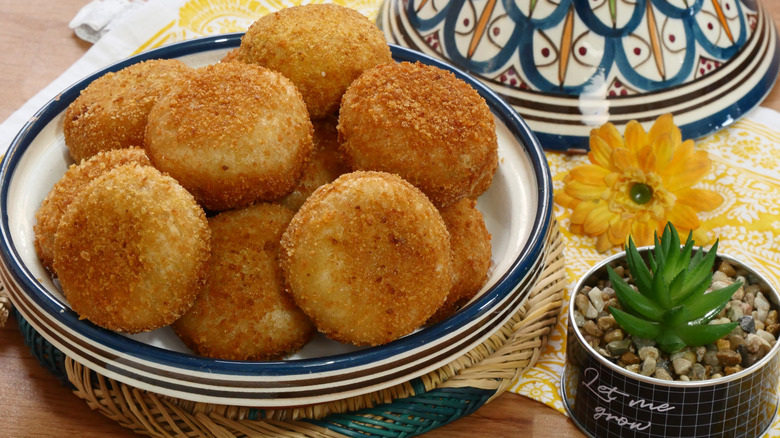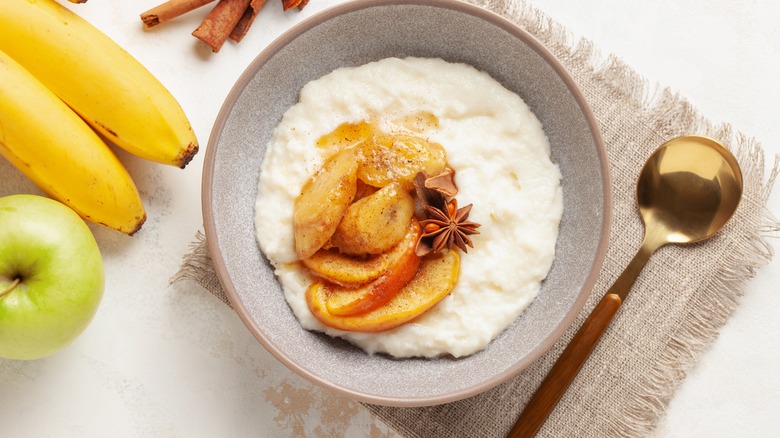15 Traditional Moroccan Dishes You Must Try At Least Once
If you're a fan of flavor and spice, you'll find many Moroccan dishes that'll grab your attention. Moroccan cuisine is all about big flavor and fresh ingredients, using foods like vegetables, legumes, pulses, spices, and herbs to make something delicious and nutritious. People who aren't as familiar with Moroccan cuisine may know about dishes like tagines made with dried fruits like apricots and prunes, and while those are worthy of their reputation, Moroccan cuisine is so vast and diverse that it goes way beyond just these few. You can find everything from juicy meatballs, hearty soup, slow cooked comfort foods, pastries, salads and dips, fresh breads, barbecue style kebabs, and more. All with the Moroccan flavors that make the cuisine so distinct and unique.
If you're not able to make a trip to Morocco, or find a Moroccan restaurant nearby, many of these dishes can be made at home too. The backbone flavors of Moroccan cuisine include using spices like turmeric, ginger, pepper, and herbs like cilantro and parsley. With these in your pocket, you can make all kinds of Moroccan dishes. As a food writer with North African heritage, I lived in Morocco for some time in search of learning and tasting everything I could about this rich cuisine. While the restaurant and street food scene is incredible all over Morocco, it's in homes where some of the most tantalizing cooking occurs. These are some traditional Moroccan dishes that you must try at least once in your life.
1. Harira
If you've ever been to Morocco, there's no chance you weren't offered or didn't try harira. Harira is a traditional Moroccan soup that packs flavor, and it's an appetizing way to start a meal or have it on its own. It's one of the most beloved and ubiquitous dishes in Moroccan cuisine, especially (but not limited to) in winter. It's hearty, nutritious, and delicious. Consisting of a tomato-based soup, it's filled with lentils, chickpeas, vermicelli, herbs, and spices. It can be made with or without meat.
Harira is often served during the month of Ramadan as the dish with which to break fast with, so it holds a special significance in Moroccan culture. One thing about harira is that you'll never find it made exactly the same everywhere. Although there are some essentials to this recipe, you'll find different regions make it differently, and even different families have their own preferences for how to make it. There's a lot of preparation involved, but there are some shortcuts home cooks can take to make it easier to prepare, like using canned chickpeas, or tomato purée instead of fresh tomatoes. However you make it, make sure to squeeze some lemon in before you start eating, and enjoy.
2. Seven-vegetable couscous
If you're ever lucky enough to get invited to the home of a Moroccan family for Friday lunch, you'll be served an impressive traditional seven-vegetable couscous. Reserved for Fridays when the whole family can get together after the midday prayers, this meal is a staple of Moroccan traditions. It usually takes hours to prepare, involving making a flavorful broth, a slow cooked piece of meat or poultry, and couscous that's been steamed in three stages. Plus the seven vegetables, of course. The exact origin of why seven vegetables are used are unclear, but seven is believed to be a lucky number. The choice of vegetables varies depending on what's seasonal, but can involve carrots, turnips, cabbage, potatoes, zucchini, pumpkin, broad beans, parsnips, etc. Basically all the hardier vegetables that can cook in a broth over time without falling apart.
Couscous with seven vegetables is also sometimes referred to as "Couscous Bidaoui" (Arabic for Casablanca), as it's believed that this dish originated in Casablanca, the largest city in Morocco. Often, it's served in a decorative manner, in the form of a mountain of couscous with the vegetables piled on beautifully in stages, making it the go to celebratory dish for large gatherings and weddings.
3. Khobz
Bread is the backbone of Moroccan cuisine, and it always accompanies meals, no matter what they are. Bread works as the vessel with which to pick up morsels of food and sauce, as most meals are eaten with hands. There are many types of bread in Morocco, but a large, round loaf of bread called khobz (meaning bread in Arabic), is the most common. Khobz is baked fresh daily, either at home or taken to a communal neighborhood oven to bake. There are also plenty of bakeries all over Moroccan cities, and people often buy their daily khobz if they don't have time to make it themselves. However people get or make their khobz, it's an absolute essential for mealtime.
It's somewhere between a focaccia and heartier loaf of white bread, as it's both soft and spongy, with a chewy exterior. It's sometimes made with the addition of semolina to the wheat flour in order to create that harder outer crust. It's totally delicious in its own right and is a must try if you're ever in Morocco, or a Moroccan bakery.
4. Kefta tagine
You may have heard of chicken or lamb tagine, but kefta tagine is just as popular in Morocco. It's the Moroccan version of meatballs and sauce, as the kefta is shaped into little balls, usually made from beef (or lamb) and they're simmered in a spiced tomato sauce until tender and cooked through. They're often eaten as an indulgence, or comfort food, and it's often a childhood favorite for many Moroccans.
What makes the kefta so flavorful is the inclusion of onions, garlic, and fresh herbs like parsley and cilantro into the meat mixture. Spices like cumin, black pepper, paprika, and sometimes cinnamon and turmeric are added, too, perfuming each bite. Then, these same spices and herbs are added to the tomato-based sauce, creating a uniform taste that brings the sauce and meat together. The final addition of eggs on top of this saucy meat dish, finishes off the tagine, making it extra filling and indulgent, although not always necessary. It's then served in the middle of the table to get scooped up with a piece of fresh khobz.
5. Pastilla/bastilla
One of the most distinct dishes in Moroccan cuisine is a sweet and savory chicken pie called pastilla (also called bastilla). It's not your regular chicken pie, as at first glance it looks like a dessert, as it's topped with powdered sugar. The chicken is cooked with warm spices like ginger, turmeric, cinnamon, and saffron, and sometimes, sugar or dates. It also has a crunchy almond filling. For someone unfamiliar with pastilla, it can be confusing to the brain on the first taste, but once you get used to the idea, it becomes incredibly moreish. When you think about it though, it's no different from eating sweet and sour chicken, or a sweet pulled pork sandwich.
Pastilla usually served at weddings, or for large dinners and banquets, as well as at tea time. In years past, this dish was traditionally filled with pigeon, however, nowadays chicken is more accessible and the most common filling (although you can also find seafood pastilla). The pastry, called "warqa", is paper thin and flaky, but phyllo pastry works as a good substitute.
6. Chicken tagine
Tagine is perhaps one of the most famous Moroccan dishes, and it gets its name from the vessel it's cooked in. The popular cone-shaped clay pot with a round deep dish at the bottom, called a tagine, is a traditional Moroccan tool that's been used to cook for centuries. Its shape allows for steam to be caught and turned into condensation, returning to the dish in order to keep it moist and flavorful, without drying out. It's a pot that's more than a cultural symbol, and is in fact used in many Moroccan homes till this day.
One of the most beloved tagine dishes is chicken tagine. Chicken is one of the affordable types of meat and is loved by children and adults alike. A chicken tagine is often made as a weeknight meal, or lunch. The ingredients are usually fairly simple, but cooked with flavor powerhouses like preserved lemons, or olives, to give it a sharp saltiness or zing. If you don't have a tagine pot, don't worry. You can make any tagine dish like this one-pan chicken tagine recipe without the vessel by cooking in a Dutch oven, or any casserole dish covered with a lid or aluminum foil.
7. Msemen
There's little as satisfying as a freshly made, still warm msemen with some tea or coffee in the morning. Msemen is the Moroccan breakfast your morning needs, or really any time of the day. This flaky, buttery, pastry is a real treat, for people who love sweet or savory, as you can have it both ways. Move over croissants. Msemen are a combination between a croissant, pancake, and flatbread, meeting somewhere in the middle with delicate flaky layers in a flat, pancake style baked good. Each layer is generously coated with butter or oil, to create a rich taste and puff-pastry-like layers.
The best part about it is that it's delicious plain, with no additions, but you can add anything from cheese, honey, jam, fruit, or even Nutella to it. It's also sometimes served with a savory ground meat stuffing, which goes by the name of rghaif. They're a little tricky to master at first, but once you get the hang of it, you can make msemen at home. However, if you ever do come across them in a bakery, get a couple to freeze as they freeze really well and you can enjoy them more often.
8. Mechoui
Mechoui is the Moroccan barbecue dish that you need to try if you ever get a chance to. Usually, a whole lamb is cooked in a clay oven underground or on a spit, using fire and charcoal, giving it that quintessential barbecue taste. Mechoui has slightly different meanings across North Africa, but in Morocco, it's the name of a dish and this technique. This is a dish that people rarely make at home, (except for more rural communities who may have the underground ovens required) so your best bet is to eat it at a mechoui restaurant. Professional mechoui makers do it best, and you'll usually be able to watch their process. Then, you'll be served with a large dish of lamb that's cooked until it's unbelievably tender.
The lamb is traditionally marinated with a garlic and tomato, or a spiced butter before it enters the pit to cook. The spices may vary, but often include cumin, turmeric, ginger, and sometimes cinnamon. Once cooked, it's served with a simple cumin and salt seasoning. Mechoui is not only delicious, but a memorable experience.
9. Baghrir
Moroccan cuisine has its own version of pancakes, called baghrir (or beghrir) which are an absolute must try if you haven't had them before. These small circular pancakes slightly resemble American ones, but there are three main differences. Baghrir contains both flour and semolina flour, they're also made with yeast, and they're only cooked on one side. The yeast creates a whole lot of bubbles, which give baghrir its signature look and feel. They're not turned over because the bubbles that form on top of the pancake while it's cooking, is what makes baghrir spongy and soak up whatever sauce you drizzle on top.
Baghrir is traditionally eaten with honey and sometimes butter melted on top and served with hot tea in the morning. It is also not as tricky to make at home as it looks, and just requires a bit of a rest time for the yeast bubbles to form.
10. Brochettes
Kebabs are a staple of most Mediterranean and Middle Eastern cuisines, and Morocco is no different. In Morocco, these go by the name "kebab" or sometimes the French name of "brochettes" and are usually made from beef or lamb. Cubes of meat are skewered and then flame grilled to perfection, making them a really popular menu item at many Moroccan fast food joints and street food vendors. They're also the choice of grilling meat for at home barbecues and are particularly popular at special occasions and around the time of Eid Al-Adha.
In Morocco, the meat is typically cut a little smaller than a Turkish kebab and it's also marinated with different ingredients like onion, fresh parsley, cumin, paprika, and olive oil. Sometimes, the meat is threaded onto skewers with alternating cubes of fat, meant to increase the flavor of the kebab while it cooks. It's optional whether to eat the fat or not. They're easy to pick up and eat with your hands, and usually served straight off the grill, dripping in flavorful fat and marinade.
11. Baked fish in chermoula
You may have heard of chermoula before as it's starting to become a trendy menu item at various restaurants. But if you're wondering what chermoula is, and how to use it, it's simply an herb and spice mixture that's used as a marinade. This zingy North African condiment is bursting with freshness and makes for the perfect flavor enhancer for many dishes. In Morocco, it's traditionally associated with baked fish, and is one of the classic dishes you must try.
It's composed of a few basic ingredients, like lemon, garlic, tomato paste, and herbs, as well as a blend of spices, making it really easy to make at home. It's mostly served with fish and seafood dishes because the flavors really compliment seafood, and also help make it less "fishy." While it can be spicy, it doesn't have to be, and you can adjust the level of heat with how much chile spice you use.
12. Lamb tagine
Lamb tagine is perhaps one of the most well-known Moroccan dishes outside of Morocco. Known for lamb being cooked in fragrant spices, with fruit like apricots and prunes, it's a luxurious dish that many associate as the pinnacle of Moroccan cuisine. It is indeed a special dish in Moroccan culture, but not one that's eaten as much as people might assume. It's considered a dish to serve to guests on special occasions, but not one that people prepare for themselves regularly.
If you get to visit a Moroccan restaurant, it's definitely worth a try, even if you're not a fan of sweet food. Firstly, you can often request for the fruit to be added or left out, but secondly, the sweetness is more subtle that you imagine, as the perfumed lamb is the standout of the dish. The lamb is often cooked until it's falling off the bone, and as soft as butter. To be enjoyed with khobz, couscous, or rice.
13. Zaalouk
Eggplant dips are pretty common along North Africa and the Middle East, and in Morocco, it's called zaalouk. For a dish that uses relatively few ingredients, it packs a punch. Moroccan zaalouk is a hybrid between a salad and a dip, as it's made with smoky eggplant and tomatoes mushed together and cooked with some herbs and spices to become one bold but uniform dish. You can scoop it up with some bread, or dip your chips in it, and you can eat it hot or cold. This makes it a versatile dish that you can serve as a starter, or even take with you to a picnic.
The key with zaalouk is to remove the eggplant and tomato skins, which people do by grilling and charring these veggies, making the skin come off easier. This also softens the flesh and starts the cooking process, before you cook it down further in a pot, along with cilantro, parsley, cumin, paprika, olive oil, and more. The added bonus is that zaalouk is totally vegan and gluten free, making it a great option for people with those dietary restrictions.
14. Maakouda
Maakouda are really not known outside of Morocco, but they're such an important part of Moroccan cuisine. Maakouda are the fried potato dumplings that are a staple of Morocco's street food. They are an integral part of many Moroccan childhoods, as they're often the first type of fast food that people encounter in their lives, or perhaps used to be as more American fast food becomes more popular in recent years. These potato dumplings are spiced with spices like paprika, cumin, and turmeric, and filled with garlic, lemon, and herbs, making them flavorful little morsels of fried potato and dough.
These can be served as a starter or a side dish, or you can make a maakouda sandwich, as is popular with street food vendors in Morocco, where you can find maakouda sandwiches doused in tangy and spiced tomato sauce, salads, harissa, olives, tuna, and deli meats. It makes for an affordable, filling, and tasty meal.
15. L'assida
Moroccan breakfast foods are some of the tastiest you can find, and baghrir and msemen tends to steal the spotlight. However, there's another breakfast option that needs some attention called l'assida. It's a sweet porridge that's made with semolina, an ingredient that's essential to many Moroccan foods and dishes. This humble porridge is transformed into something decadent, and is associated with celebration as it's enjoyed during the days of Eid Al-Fitr, in Morocco, and in other Maghreb countries like Algeria and Tunisia.
This comforting breakfast is not too sweet, and is often served with honey and enriched with butter, making it extra luxurious. More elaborate versions include toppings of dates, pistachios, and dried fruit. While some recipes call for using couscous, it's best made with fine semolina to be turned into a smoother porridge. It's an affordable ingredient that you can make a big pot of to feed a large amount of people, making it a very popular dish.
